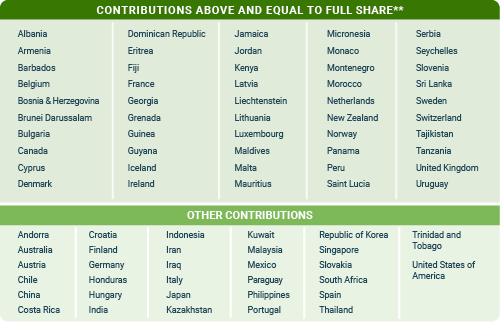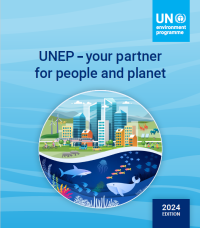The Environment Fund, established already in 1973 by the UN General Assembly, is the core financial fund of the UN Environment Programme (UNEP). As the main source of unrestricted funds, provided by Member States, it enables strategic and effective delivery of results, while allowing for flexibility to respond to emerging environmental challenges.
The Fund provides the bedrock for the work of UNEP worldwide, supporting countries to deliver on the environmental dimensions of the 2030 Agenda. It is critical to the work in science, policy and environmental governance and law, which in turn helps drive positive impact for the environment.
The Environment Fund is used for:
- Implementation of the Medium-Term Strategy and its programmes;
- Keeping the environment under review. For example, flagship scientific publications such as the Global Environment Outlook, the Global Chemicals Outlook and the Emissions Gap Report translate the best available scientific knowledge into information relevant for decision makers, who then can turn policy into action;
- Identification of new emerging environmental issues (such as through the Frontiers-series).
- The work on several science-policy platforms that bring together scientists, governments, industrial and international organizations, and civil society;
- Innovation for addressing environmental challenges;
- Advocacy and awareness raising on environmental issues;
- Capacity building and transfer of technological innovations;
- Results-based planning and management;
- Bringing together governments, the private sector and civil society in advancing the global environmental agenda, for example through the UN Environment Assembly;
- Hosting the secretariat of many critical multilateral environmental agreements;
- Robust oversight.
Of the Fund, 87 per cent is used for the thematic sub-programmes. The rest supports strategic direction, management and programme support, which are critical for implementing the organisation's vision and ensuring robust oversight and delivery.
This video explains why the Environment Fund is critical to UNEP:
Contributions to the Environment Fund
In 2023, the Environment Fund provided US$ 89 million, or 15 per cent, of UNEP's total income. The income received represented 89 per cent of the approved budget. To see current information on all contributions and contributors to the Fund, visit the Contributions page.
Who are the contributors to the Environment Fund?
Since 2012, UNEP membership encompasses all 193 UN Member States, who are responsible for funding the programme. By the end of 2023, 80 Member States had contributed to UNEP, out of which 48 contributed at their full share (see below). Currently, the top-15 funding partners provide over 90 percent of the income. (all figures as at Dec 2023)
What is each Member State's share of the Environment Fund?
The share that each Member State is encouraged to contribute to the Environment Fund is represented by the Voluntary Indicative Scale of Contributions (VISC). The VISC was established in 2002 by the UNEP Governing Council. The aim of the VISC is to broaden the base of contributions and to enhance predictability in the voluntary financing of the Environment Fund. See our Frequently Asked Questions on the Environment Fund for more information.
Because one size does not fit all, the requested share is tailor-made for each country.
The VISC is based on the UN scale of assessments, but also takes into account other criteria, such as each Member State's economic and social circumstances, previous high levels of contributions etc. Based on these criteria, the VISC proposes the percentage that each Member State is encouraged to contribute to the UNEP's Environment Fund.






